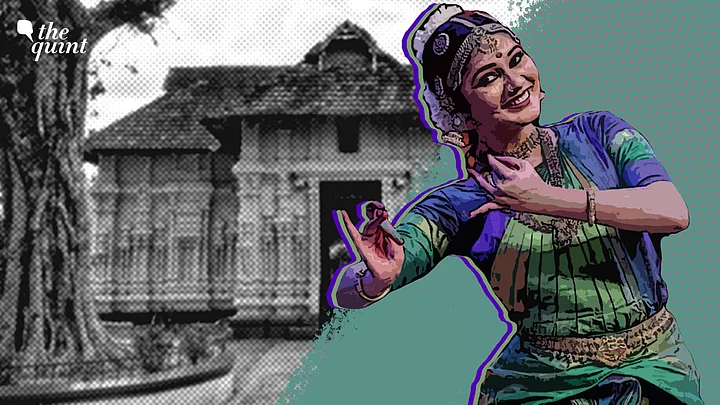Bharatanatyam dancer VP Mansiya was not entirely surprised when Koodalmanikyam temple authorities called her to cancel her scheduled performance at their festival. In the past five years, the 27-year-old dancer who was born in a Muslim family in Kerala, has already been denied entry to temple venues twice.
Koodalmanikyam, located at Irinjalakuda in Thrissur district, was the third temple that denied her dance venue on account of being a non-Hindu. While her performance at the temple was slated for 21 April, Mansiya was told on 27 March that she will not be allowed entry as she is not a Hindu.
Mansiya told The Quint, “In 2017, at a temple in Malappuram district I was asked to perform on a stage which was not within the temple premises. It was made only for me as they could not give me the usual venue given to Hindu dancers. In 2019, entry to Melpathur auditorium was denied.”
Melpathur is the arts auditorium of the famous Sri Krishna Temple at Guruvayur, Kerala. “Melpathur temple authorities told me that they could face a backlash if I were to perform there.” Ironically, Mansiya had done her arangeettam or first stage performance at Melpathur.
The dancer has also been facing ostracism on religious grounds, albeit from Muslim religious leaders.
Religious Ostracism from Childhood
Mansiya’s father and mother were practicing Muslims. Her father, VP Alavikutty, was employed in the Middle East. In Mansiya's teens, her mother Amina introduced her to dance. “My mother loved classical dance performances which used to be aired on television periodically. She enrolled my elder sister, Rubia, and myself for dance tutorials at a young age.” Shortly after, trouble brewed.
In 2007, the family was expelled from their local Muslim congregation or mahal, as the religious leaders branded classical dance an ‘un-Islamic’ artform.
“They felt we were performing a Hindu artform.” At the time, Mansiya’s mother was struggling with cancer. When she died later that year, the local mosque refused to perform her last rites.
Amina, a devout Muslim for whom religion was an integral part of life, had to be buried in the graveyard of a mosque near her maternal home. “My father, sister, and I were not allowed to attend the burial. I stopped practicing Islam on that very day,” Mansiya recalled.
She could, however, never really shirk off her Muslim identity, especially whenever she danced in public. She was always known as the 'Muslim girl' performing a 'Hindu artform'. “I never liked it. Art is secular. How can art belong to any religion?” she rued.
Mansiya kept performing, despite hurdles, because dance became her religion, she said.
Even as she had learnt Kuchipudi and Kathakali, she chose Bharatanatyam because it suited her body language the most. She travelled to Chennai to do her Master of Arts (MA) in Bharatanatyam. Later, Mansiya completed her MPhil in Bharatanatyam at Kerala’s renowned performance school, Kalamandalam. She is pursuing her PhD at the same arts school.
The Kalamandalam banner, which should have ideally helped her get more venues, has not really boosted Mansiya. Her non-Hindu identity kept holding her back, at times.
Koodalmanikyam Setback
When Mansiya thought of performing at Koodalmanikyam festival, which has been hosting exceptional performers for over three years, she was asked to send her biodata. “They assured that they would consider only my performance background. But things changed shortly,” Mansiya said. After advertising the date of her performance, the temple authorities seemingly had an afterthought.
“It was the way in which they denied me entry that was the most hurtful. They asked me why I had not converted to Hinduism even after marrying a Hindu.” The dancer had married violinist Shyam Kalyan three months ago.
Did the temple authorities first assume that her marital status made her a Hindu? “The committee members of the festival even told me that they would allow me to perform if I converted to Hinduism. I refused the offer,” she said.
Mansiya’s dance is now restricted to her home, where she practices Bharatanatyam for at least three hours a day. “Even those practice sessions give me immense pleasure. I am content,” she smiled. But don't artforms attain meaning when performed for an audience?
Does she miss the crowd? “Yes I do. But I brought public attention to the temple’s decision to deny me my right to perform because I felt that this would help others who come after me,” she said. Mansiya wants younger performers to get more avenues than what she managed to get.
‘Classical Dance Still Limited to Temples’
Most of Mansiya’s performances have been at venues attached to temples. “In places like Delhi and Chennai there are secular places to perform classical dance. In Kerala such public stages are limited,” she explained. The state government should create avenues for artistes of all castes and religions to perform, she further said.
“While performances at temple venues could continue, there should be alternate spaces where classical dance can be performed. Only the state government can ensure this,” Mansiya insisted.
With India being a secular country and Kerala a state which is known to be progressive, artistes should not be denied their right to perform on account of their religion, she opined.
Mansiya wants to perform on stages, even those associated with temple properties, in the future. However, when Vishwa Hindu Parishad expressed interest in offering her a venue, she politely refused. "No, thank you," Mansiya responded.
(At The Quint, we question everything. Play an active role in shaping our journalism by becoming a member today.)
